This Update covers May 1st - May 31st 2008. It is in three parts:
In addition to the impacts of reclamation on Saemangeum and other intertidal wetlands (see Birds Korea news below), two other recent and long-running sagas of note in May concern the continuing outbreaks of Highly Pathogenic Avian Influenza in poultry farms throughout much of the nation, and the proposed Korean Grand Canal.
Outbreaks of HPAI continued throughout much of the month, largely without much concern on the part of the public, but now with some protests from farmers, seeking government compensation “over reckless government comments” (Yonhap News, May 23rd), blamed for a drop in the consumption of poultry. Government and media focus, however, has remained very much more on the mass protests against importing beef from the United States of America into Korea rather than on outbreaks of Poultry Flu, which reached Seoul and apparently Busan during the month.
Meanwhile, the newly-formed Ministry of Land, Transport and Maritime Affairs (the main government proponents of the Korean Grand Canal) ended May by reaffirming their commitment to the project, intended to canalize all of South Korea’s major rivers (Korea Herald, June 2nd). No sooner had this decision been announced, however, than the Grand Canal was apparently put on hold (note: not cancelled), with the Korean Herald Editorial (June 4th) even suggesting that the President “will scrap the cross-country canal” in a move “to allay the public discontent stirred up by the administration's clumsy handling of U.S. beef imports”. It is interesting to note that this sudden shift in public stance on the Korean Grand Canal at this time also coincides with the 37th Standing Committee meeting of the Ramsar Convention being held in Korea, and comes only days after a strong letter of concern was sent by BirdLife International (at Birds Korea’s urging) to the President’s office in late May. Clearly, canalization of Korea’s rivers, leading to a loss of biodiversity and the severe degradation of eight or more Important Bird Areas, is an issue of growing domestic and international concern that needs to be addressed and discussed openly in the run up to and the context of the Ramsar Conference in October.
May was, yet again, an extraordinarily busy month for our organisation, and indeed for many environmental groups now preparing for the upcoming Ramsar Convention conference (to be held in Korea between October 28th and November 4th this year). For Birds Korea, our main work included the second month of Year Three of the Saemangeum Shorebird Monitoring Program (SSMP); a national survey of inter-tidal wetlands along the west and south coast (May 2nd-May 13th); and work on several bird conservation texts. Related media coverage in the month included local newspaper articles in both Mokpo and Gwangju and KBS TV coverage (apparently broadcast nationally) on the ongoing shorebird and wetland conservation work at Mokpo Namhang Urban Wetland, and an interview on the meaning of the Ramsar Convention for a nationally-broadcast documentary on EBS.
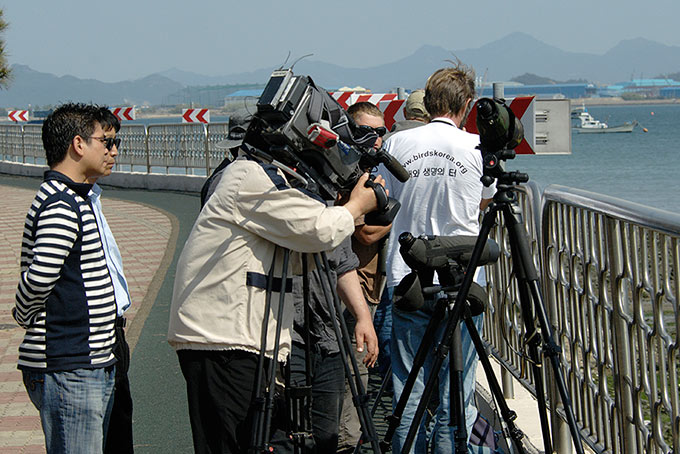
Through this consistent and collective effort and focus on shorebirds and Yellow Sea inter-tidal wetlands, Birds Korea and our partners in the SSMP, the Australasian Wader Studies Group (AWSG), have now generated the data to state unambiguously that the Saemangeum reclamation has caused massive impacts on many shorebird species, including causing a major decline in South Korea’s Great Knot Calidris tenuirostris. Further, we can state that other shorebird species such as Black-tailed Godwit Limosa limosa have also shown a significant decline at the national level in recent years.
As background:
Saemangeum was until 2006 recognized as the single most important shorebird site in the Yellow Sea (itself a core region in the East Asian-Australasian Flyway), supporting at least 19 species of shorebird in Ramsar Convention-defined internationally important concentrations (of more than 1% of population), including a third of the world’s Great Knot (a species that spends the winter largely in Australia, and migrates through Korea in both spring and autumn to and from its Russian breeding grounds).
The national Ministry of Agriculture and Forestry felt able to claim that displaced shorebirds from the 40,100 ha Saemangeum reclamation would “easily move their habitat to the Gomso Bay, Geum River estuary or other tidal flat (239,000ha) which are 5 ~ 20km away from Saemangeum.”
However, there was no comprehensive government program put in place to monitor the impacts of the Saemangeum reclamation on shorebirds, to test the Ministry of Agriculture and Forestry’s claims. This was despite the Ramsar Bureau formally requesting (first in 2005) “the government of the Republic of Korea to advise the Secretary General of the current situation concerning the sea-wall construction and reclamation of the Saemangeum coastal wetlands, and the impacts of the construction works undertaken to date on the internationally important migratory waterbird populations dependent upon these wetlands” (Ramsar Resolution 9.15).
There has also apparently been no adequate government shorebird monitoring program in place at the national level either, despite additional commitments held under the formal “Agreement between the Government of the Republic of Korea and the Government of Australia on the Protection of Migratory Birds” (ROKAMBA). ROKAMBA specifically covers 59 bird species, many of them shorebirds, including 15 shorebird species found in internationally important concentrations at Saemangeum alone. Species covered by ROKAMBA therefore include both the Great Knot and the Black-tailed Godwit. ROKAMBA’s Articles contain a formal commitment to “encourage the formulation of joint research programs on migratory birds”; to “take the appropriate measures to conserve and improve the environment of birds protected under Article 1 of this Agreement”; and to “seek means to prevent damage to such birds and their environment.”
To this background, Birds Korea and the AWSG developed the Saemangeum Shorebird Monitoring Program (SSMP), initially set to run in April and May 2006, 2007 and 2008. Thanks to the enormous generosity of time, energy and skill of all who have participated, as well as to essential funding support from private donors and the David and Lucile Packard Foundation, the SSMP has for three years gathered and disseminated data on the impacts of the Saemangeum reclamation on shorebirds, through conducting repeat counts at Saemangeum and the adjacent Gomso Bay and Geum Estuary. Further, this May (funded by private donation and by “The Korean NGO Promotion”) we also conducted a national shorebird survey, counting shorebirds at all thirteen of South Korea’s most important shorebird sites, as well as at other nationally important sites (including Mokpo Namhang Urban Wetland).
After this intensive and transparent survey effort, we can now state with confidence that:
Numbers of shorebirds within the Saemangeum reclamation area have declined significantly (by more than 137,000 between May 2006 and May 2008);
Numbers of shorebirds within the SSMP Study site, of Saemangeum, the Geum Estuary and Gomso Bay, have also declined significantly (by between 97,000 and 105,000 in the same period, between May 2006 and May 2008): the majority of displaced birds have therefore not been able to “move their habitat to the Gomso Bay, Geum River estuary”;
Numbers of Great Knot within the SSMP study site (of Saemangeum, the Geum Estuary and Gomso Bay) have declined from a peak of 116,000 in May 2006, to only 21,000 in May 2008, a decline of almost 95,000.
Despite counting all major shorebird sites nationwide, these Great Knot “lost” to the Saemangeum reclamation were not found: they are also “lost” to South Korea.
Further, there is no evidence that other shorebird species displaced by the Saemangeum reclamation have been able to move to other sites within South Korea; rather there is a large body of evidence to show that shorebird numbers in total have fallen in recent years. These declines are most apparent in the Black-tailed Godwit and the Great Knot, and are most obvious at sites affected by reclamation (such as Asan Bay).
Further, work now being conducted by the AWSG, as part of the Monitoring Yellow Sea Migrants in Australia (MYSMA) program, has also revealed that numbers of Great Knot wintering in Australia have shown a sudden, sharp and significant decline. The conclusion: reclamation in Korea is impacting not only the environment and biodiversity of Korea, but also the shared biodiversity of other nations.
Our count data have already been made open through online publication (SSMP Update May 26 2008; NSS 2008 draft summary). Further, data and analysis from 2006 and 2007 have also already been published in formal reports and in the Stilt, made accessible in Korean and English (and in some cases, in other languages too, including Chinese), while data from 2008 will be presented in the 2008 SSMP report, other publications in Korea, and as intended international publication.
There are now tentative plans to conduct a fourth year of the SSMP (in 2010). In the coming months, our commitment remains to make this information and data available to all, especially in the run-up to the Ramsar Convention conference, and especially to decision-makers, who (with public support) are ultimately responsible for helping the nation to fulfill existing obligations and “international responsibilities for the conservation, management and wise use of migratory stocks of waterfowl” (Ramsar, Article 2.6), under national legislation, under bilateral agreements (including ROKAMBA), and under international conventions, including Ramsar and the Convention on Biological Diversity (CBD).
All governments that sign the Ramsar Convention, by signing it, agree that “The conservation of wetlands and their flora and fauna can be ensured by combining far-sighted national policies with co-ordinated international action.” (Ramsar Convention Preamble). Birds Korea believes that the SSMP and National Shorebird Survey (conducted through international cooperation, and combined with public-awareness raising work), provide all levels of government with essential support in their efforts to “Develop national strategies, plans or programmes for the conservation and sustainable use of biological diversity” (CBD: Article 6a).
In June, work will also start on a major new project in Mokpo. Funded by a grant from the UNDP-GEF Yellow Sea Large Marine Ecosystem project, the project’s title is “Establishing preliminary guidelines, processes and basic designs for the enhancement, restoration and ‘Wise Use’ of the Mokpo Urban Wetland.” The small and highly modified Mokpo Urban Wetland already supports a good range of migratory waterbirds, and has the potential, if managed appropriately, to provide enormous benefits both to wildlife and to people. This project offers a substantial opportunity for Birds Korea to help develop guidelines on management through collaboration with local experts and other organisations, and through input from international experts, at a very significant time: the run-up to the 2008 Ramsar Convention conference.
Further work in June also includes the development of an environmental education textbook (commissioned by the Nakdong River Office of the Ministry of Environment’s Korea Wetlands Project); work on a chapter on Korean inter-tidal wetlands, Ramsar and birds, for a book being produced by the Tidal-Flat Conservation Forum; and further behind-the-scenes work on our Korean-language website.
One major change to plans in June announced in the last update: The Environmental Education English Camp, previously planned for the weekend of June 21st and 22nd, has been moved to August 23rd and 24th . We would greatly welcome hearing from experienced teachers and educators (many of whom have advised us to do more work on environmental education) to make the best programme and materials possible: many thanks in advance!
May is often one of the most exciting birding months of the year. In 2008, exceptional highlights included the second Large Hawk-Cuckoo Hierococcyx sparverioides and the first photographed Ortolan Bunting Emberiza hortulana for Korea.
Japanese Night Heron Gorsachius goisagi EN, V1 (So)
One adult was found and photographed near Buan on May 4th by SSMP members and was present until at least May 9th; and one was photographed (presumably on Jeju Island) and posted on the Birds in Jeju website on May 6th. A further Gorsachius Night Heron was also found on Socheong Island by Robin Newlin on 12th, being photographed by Nial Moores on May 18th. While likely a second calendar year Japanese Night Heron, based on present knowledge and its blackish crown and pale-tipped primaries, Malayan Night Heron G. melanolophus cannot perhaps be fully ruled out.
Black Bittern Dupetor flavicollis V3 (So)
One photographed on Heuksan Island, Shinan Gun, by Park Jong-Gil on May 30th is approximately the tenth national record.
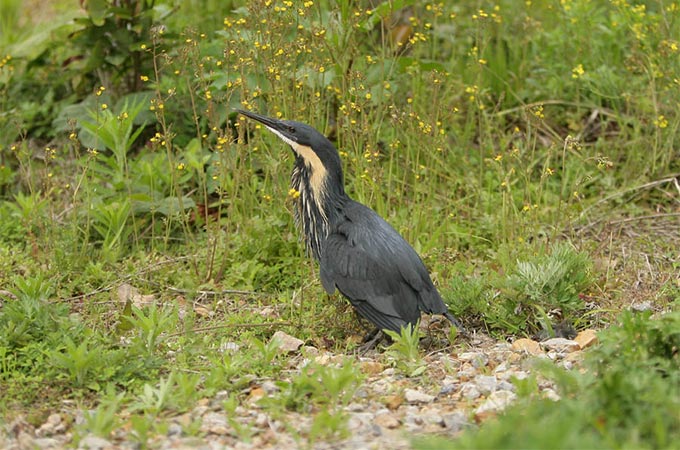
Lesser Frigatebird Fregata ariel V2
One juvenile was seen flying over Seosan lakes on May 6th (Nial Moores and Adrian Riegen). This is probably approximately the 11th national record.
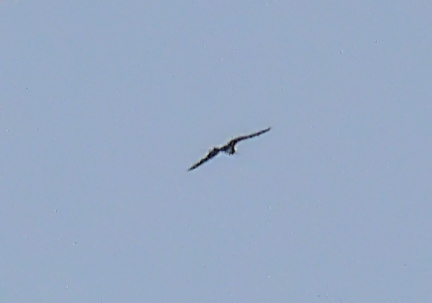
White-breasted Waterhen Amaurornis phoenicurus INC, P5 SV3 WV3
A pair was noted in territory in an area of damp grassland in Suwon City during May, and a nest was found (Shim Kyu-Sik). However, the entire area was then bulldozed for construction. This constitutes probably only the 2nd documented breeding attempt nationally.
Band-bellied Crake Porzana paykulli NT, V2
One was taken into care at Gangseo-gu, Seoul area on May 23rd, photographed (Gwak Ho-Kyoung and Jeong Jin-Mun/KWBS), and released several days later at Uiwang Reservoir. There are only c. 12 previous records of this species, most recently in May 2007.
Pied Avocet Recurvirostra avosetta V1
Twelve photographed at Hwaseong (Namyang Bay Reclamation Area) on May 8th (Shim Kyu-Sik) is the highest concentration recorded nationally to date.
Asian Dowitcher Limnodromus semipalmatus NT, V2 (So)
Three different individuals were found by the SSMP 2008 in May: one on Yubu Island on May 8th; one at the Dongjin Estuary within Saemangeum, and one at the Geum Barrage (last on 24th).
Nordmann's Greenshank Tringa guttifer EN, P4
Peak counts recorded by the SSMP and the National Shorebird Survey in May included two on Yeongjong Island (May 3rd), 11 at Song Do (May 3rd), 34 at Namyang Bay (May 5th), one at Asan Bay (May 5th), 56 at the Geum Estuary (May 8th), five at Saemangeum (between 8th and 10th), one at Haenam (May 12th) and two at Suncheon Bay (May 12th).
Spoon-billed Sandpiper Eurynorhynchus pygmeus CR.DEC.P4
The only records so far known to Birds Korea this year have been by the SSMP. None were found away from Saemangeum and the Geum Estuary by the National Shorebird Survey. There were three together within Saemangeum on April 28th, two in a slightly different area on May 6th (same or different individuals?), one near the Airport on 20th, and two at Simpo, on 22nd. At the Geum Estuary, the first was recorded on May 5th (at Wulpo), with eight on Yubu Island on May 8th, falling to seven there by the 11th and four on 24th.
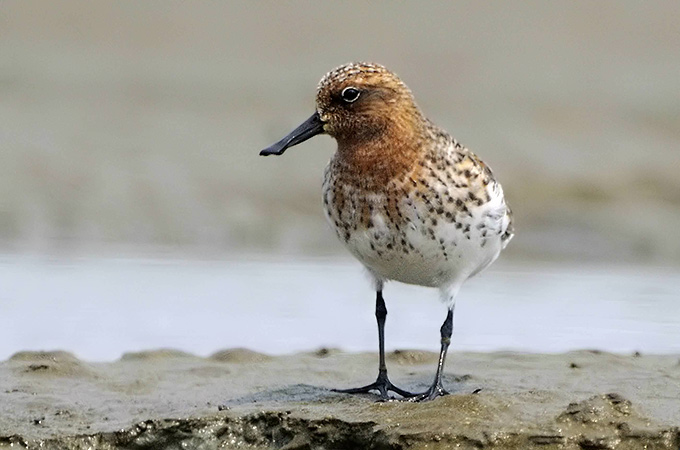
Broad-billed Sandpiper Limicola falcinellus DEC, P3
1130 at Yubu Island on May 24th (SSMP) is the largest single concentration of this species known to Birds Korea: the largest previous day count was a combined 1251 at various sites within the Saemangeum reclamation area, on October 12th 2007.
Mongolian Gull Larus mongolicus P2 W3 S4
At least five breeding pairs were found nesting at a site in Incheon on May 3rd (National Shorebird Survey). On May 12th, eight nests, one containing two chicks, were then observed by Tim Edelsten at the same site. This appears to be the first mainland breeding record for this species, although it is already known to nest on several islands off the west coast.
Gull-billed Tern Gelochelidon niloctica V3(So)
One was photographed at Hwaseong, Namyang Bay, on May 7th by Yu Dae-Ho. At Saemangeum, one was photographed on May 23rd, with the same bird photographed on the 24th at the Geum Barrage. In addition, one was seen at Yubu Island on the 24th: either the same or a second individual. There have been less than 10 records nationally to date.
Red Turtle Dove Streptopelia tranquebarica V2
One female-type was photographed on May 11th by Kim Hyo-Gon, on Weiyon Island. Another was photographed by Park Joo-Hyun and posted to the http://www.birddb.com website on May 16th: this was then followed by a male and a female (photographed together) on Weiyon island on May 24th, and a female on May 27th posted to the same website.
Large Hawk-Cuckoo Hierococcyx sparverioides V3(So)
One (heard only) on Socheong Island on May 12th by Robin Newlin is the second record of this distinctive-sounding species in Korea. The first record, also from Socheong Island, was heard and seen between May 19th-22nd, 2007.
Eurasian Crag Martin Ptyonoprogne rupestris V3 (So)
One seen on Socheong Island by Robin Newlin on May 12th is approximately the 5th national record, since the first in 2002.
Light-vented Bulbul Pycnonotus sinensis INC, SV1 RV3 (So)
Two seen on Baengneong Island (Robin Newlin) on May 10th, and one photographed on Seungbong Island (Tim Edelsten) on May 24th, both represent new sites for this species.
Siberian Chiffchaff Phylloscopus (collybita) tristis V3
One on Socheong Island, seen by Nial Moores on May 17th is only the 8th record for the Korean peninsula.
Blue Rock Thrush Monticola solitarius S2 R4
One, an intergrade pandoo and philippensis (largely blue below, with very obvious reddish undertail coverts) was photographed (Joh Seong-Sik) on May 14th on Hong Island, Jeollanam Province.
White-throated Rock Thrush Monticola gularis P4 S5
Following a rainstorm on Weiyeon Island, c.100 were seen on May 18th ( Shim Kyu-Sik). This is easily the highest national day count to date. High counts of this species also came from Socheong Island, with 16 on May 18th and 21 in a separate area on 19th (Nial Moores, Joan & Scott Holt), and 14 on both 18th and 19th on Eocheong Island (Adrian Boyle & Chris Hassell).
Citrine Wagtail Motacilla citreola V1
Three on Heuksan Island on May 3rd (Aurélien Audevard) is the highest day count known to date, at least in 2008.
Tree Pipit Anthus trivialis V2(So)
A rare but annual vagrant, first recorded in 2000. One was photographed on May 1st on Heuksan Island (Aurélien Audevard), with a second photographed on May 18th on Weiyeon Island (Shim Kyu-Sik).
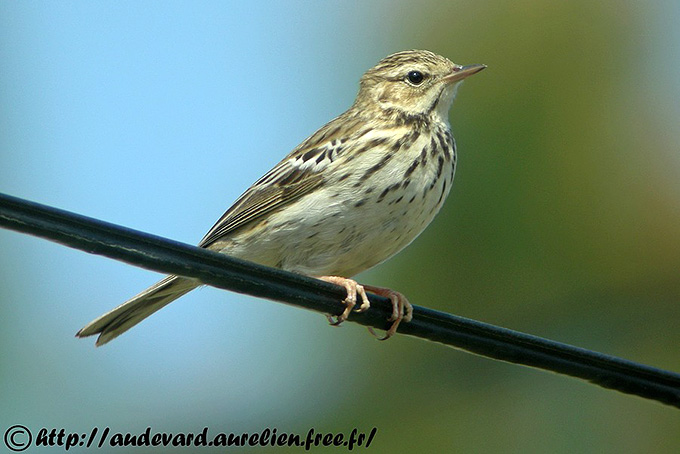
Common Redpoll Carduelis flammea DEC, V1
One photographed and posted to the http://www.birddb.com website on May 7th is only the second recent record for Korea, after one earlier in February this year.
Ortolan Bunting Emberiza hortulana V3(So)
One male photographed on Weiyeon Island on May 25th is the first record supported by photographs (Yu Dae-Ho) in Korea. As such the species will be moved to Category One of the Birds Korea Checklist during the next list revision (in July 2008). There are at least two previous sight records (both by Nial Moores, and both on Gageo Island, Jeollanam Province in 2000): one adult male on May 2nd, and one adult female or first winter male (also seen by a TV documentary crew, but not filmed), on November 9th.
Belated news, from April 2008
Himalayan Swiftlet Aerodramus brevirostris V2 (So)
One was photographed (Park Jong-Gil) on Daeheuksan Island on April 30th (preceded by one on Hong Island on April 27th),
Yellow Bunting Emberiza sulphurata VU, P5.
Twenty between 22nd and 24th April on Heuksan Island, Shinnan Gun (Aurélien Audevard) is an excellent count.
Finally, a gentle reminder to all of our members, past and present, living in Korea. Birds Korea depends entirely on the support of our members and volunteers. Donations and domestic membership fees are vital to us! Please renew your membership (annual membership fee is only 30.000 Korean won; and life-time membership only 150.000 Korean won at this time), and help us to help the birds!
Birds Korea, June 9th, 2008.



